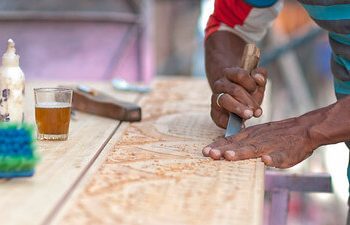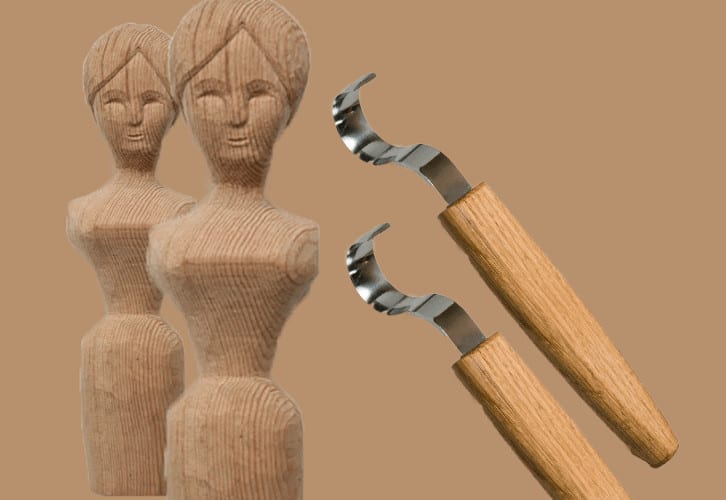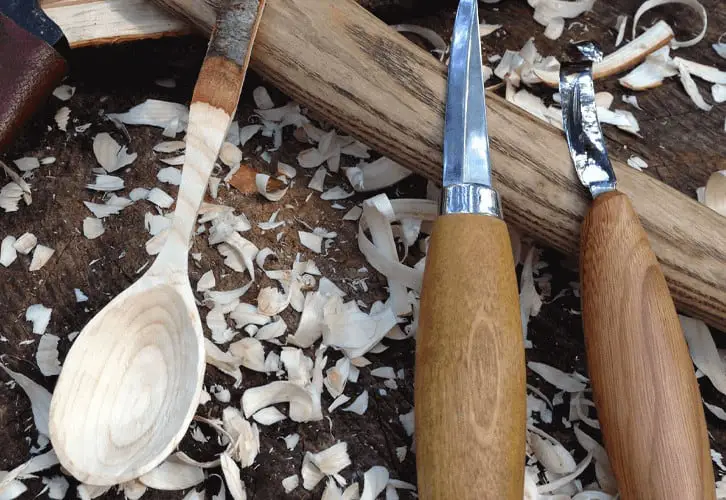Many beginners and intermediate wood carvers often ask; Can you carve pine wood? In all fairness, I reply, “no.” Pine is softwood and not desirable for carving because it does not hold up well to abuse. However, in researching this article, I found out that pine has many uses by artists who carve with it.
You can use pine wood for carving. Pinewood is also a good choice for whittlers as it is soft. However, there are a few things that you should be aware of before carving pine wood.
is pine good for whittling?
Pine trees are common in some parts of the United States. Some have called it “the workhorse of the lumber industry” because of its popularity and cost-effective production. Pine is easy to use as a building material for homes or furniture. But can carvers whittle pine?
The answer is yes you can carve pine. Carvers can utilize pine wood to make a wide range of projects. Projects include a variety of wooden crafts, from birdhouses and bowls to chairs and tables.
Pine holds details well, which is perhaps why some carvers prefer it. The grain appears more coarse than harder woods, but pine is easier to learn for beginner carvers.
The best pine wood for carving

There are many varieties of pine wood in the market today. The best pine for carving is the sugar pine, also known as yellow pine. It has a tight grain that is easy to carve, and tools cut well into it. An added advantage is that it does not develop large amounts of pitch when you burn it or carve it.
High-carbon steel blades are the best knives for handling pine. These are strong enough to handle the stresses when cutting into the wood.
Finishing Pine Wood
Pine can be stained and finished as easily as other woods. It may not hold up for the long-term outdoors. However, many of us display our projects indoors away from moisture and similar damaging elements that could cause the project to fail over time.
Pine is also inexpensive, which makes it appealing to the budget-conscious carver.
While some disadvantages are associated with using pine wood for carvings and other projects, there are advantages.
If you are a beginner, check out Wood Carving for beginners
You may also find this article of interest to you
Advantages of using pine

Some advantages of using pine wood for carving projects are that it is inexpensive, readily available in many regions, and takes to paint or stains well. Because of the availability of pine in America, many American beginner whittlers will ask can you carve pine? Now that you can carve pine, let’s look at some of these advantages in depth.
Pine Wood is less expensive than hardwood.
Because pine wood is so inexpensive (compared to hardwood species), it’s a great choice for budget-minded carvers. I found there more people that now carve pinewood quoting, “pine takes paint and varnish well, making it a good option for indoor furniture projects used in decorative ways.”
Uniform grain in pinewood
The grain of pine is much more uniform than many other types of wood. It is ideal for someone who desires to take advantage of these patterns in their project.
The uniform grain pattern makes it easier to see the direction your cuts need to go in so that you can make the most of your wood.
Reclaim Used pine wood for carving
Used pine works well for carvings, as long as you know that the grain may be a little inconsistent due to its knots.
If you work around this, your finished product will look great! Sculpting is a popular option for carvings made from used pine lumber.
Disadvantages of carving pine
Now let’s jump straight to why you might want to reconsider using pine for wood carving.
Pitch pockets in Pinewood
The major pine problem that anyone choosing to work with this wood should be considered is the pitch pockets. Insects cause these as they bore into the wood. Carving or burning a pine with pitch pockets may cause the pockets to burst and ruin the project. To avoid this problem, cut small pieces off from the edge of larger pieces until you get one with no pitch pockets.
The density of pine wood
Pinewood density makes it hard for some tools to penetrate deeply enough to engrave it fully. However, as you get used to carving with pine, you will develop techniques that help you handle this problem by using sharp tools and cutting in multiple passes.
Tips when carving using pine wood
Cut with the grain

When carving pine, you should always cut with the grain or at a 90-degree angle it. This is especially important when carving near the ends of pine pieces because you don’t want your piece to split in half.
In these areas, make sure that all of your cuts go through multiple growth rings.
Look for diagonal lines on pine wood to help figure out which direction the grain goes in. If there are no lines, you can use the “push-pull” technique to decide how to carve out an area.
Run your thumbnail along one edge until it stops and “pushes back.” The other edge will feel smooth because it pulls toward you as you gently push down on it. These textures indicate differences between growth rings and show the direction the grain goes.
Practice with hardwoods before trying pine!
As with any carving, practice on scraps to feel your tools and how pine will react to being carved. I don’t recommend using pine or other softwoods like cedar when first starting or working on small projects.
You’ll want to ease into it! Pine is better suited as a material for simple 3-D figures like animals or decorations that showcase your skills. To prevent splintering, which can be frustrating and painful, use plenty of sandpaper and rough up both sides of the wood before sanding down areas that need thinning.
If you end up with splinters from carving too aggressively, apple cider vinegar helps remove them quickly!
Safety Considerations when whittling pine
You must choose the right type of wood for each project. Pine tends to splinter, so you’ll want to carve it carefully and avoid working on intricate projects with this softwood. Some pine varieties are harder than others, which makes carving them easier.
When first starting, find a good hard or semi-hardwood like cherry, maple, or hickory instead. You’ll have more success carving these until you gain enough experience to work well in pine.
There’s less pitch on kiln-dried pine than on green or freshly milled pine wood. The pitch pockets often occur in freshly cut pieces of pine. It happens as the sap rises to the surface while the trees grow.
These pockets can make carving difficult and may result in having you throw away boards due to them being too damaged by their pitch content. Avoiding fresh lumber when choosing your stock can save you time and money by avoiding this pitfall.
To conclude; is pine good for whittling?
Using pine wood for carvings can be risky. That being said, use the suggestions in this article to help you choose your stock wisely. I hope this helps reduce the risk of damaging your project with patch pockets. Keep in mind that there are many types of pine.
Read about other good woods for carving
More resources on pinewood

